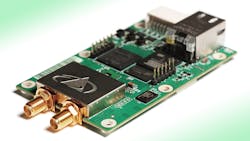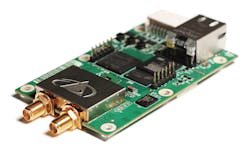This file type includes high resolution graphics and schematics when applicable.
Ultrawideband (UWB) radio technology was once considered a global solution for achieving point-to-point high-data-rate communications by means of low-energy pulses. But, as Time Domain has shown with its versatile PulsON P440 radio transceiver module, there are a number of other uses for this technology.
With the right software, UWB technology can be used to perform precise wireless ranging between two P440 radio transceivers, boasting impressive accuracy over great distances. The radio employs packet communications techniques from 3.1 to 4.8 GHz. Its flexible systems can also perform monostatic, bistatic, or multistatic radar analysis, even conducting communications at rates from 19.2 to 612 kb/s. In fact, a PulsON P44 can perform range determination, data transfer, monostatic radar analysis, and multistatic radar analysis simultaneously.
The PulsON P440 packet radio module (see figure) employs pulsed signals much like a radar, although it operates with at least one additional radar to form a network. The maximum operating range of this network is a function of a number of variables, including transmit power (typically about 50 μW), pulse repetition rate, and the type of antenna used, but distance measurement resolution of 2 cm is typically achieved at distances to 600 m or more.
Each UWB module uses coherent radio techniques to boost the signal-to-noise ratio (SNR) and dynamic range by increasing the energy summed per number of pulses in a given amount of time. The power per pulse is not increased to increased reception, though the average amount of power transmitted over a pulse interval does increase. Essentially, the amount of energy transmitted per unit time is adjusted to optimize the dynamic range of the radio as needed.
The PulsON P440 operates with a nominal pulse repetition frequency of 10 MHz and at different pulse integration rates to achieve the required dynamic range. A variety of different pulse integration rates are available, with higher integration rates yielding wider dynamic range. For example, a pulse integration rate of 1 (which equates to instantaneous operation) provides a dynamic range of 30 dB. A pulse integration rate of 16 yields a dynamic range of 42 dB, while a pulse integration rate of 64 produces a dynamic range of 48 dB. Each 6-dB improvement will double the operating range.
The UWB radio module is based on a proprietary fully-integrated-front-end (FIFE) silicon integrated circuit (IC). It is designed for compliance with the frequency masks established by compliance organizations such as the Federal Communications Commission (FCC) in the United States and the European Telecommunications Standards Institute (ETSI) in Europe. The module transmits at low powers that will not disrupt existing communications systems, achieving a maximum power spectral density of -41 dBm/MHz. This spectral density equates to approximately 50 μW or -13 dBm with an adjustable power range of about -33 to -13 dBm.
The PulsON P440 UWB radio module incorporates standard SMA coaxial connectors on its antenna ports. The radio is compatible with Time Domain’s Broadspec Torroidal Dipole Antenna, as well as many third-party antennas. An antenna control transfer switch makes it possible to configure the antennas as transmit/receive on both antenna ports or, alternately, transmit on one port and receive on the other port.
The UWB radio employs an Application Programming Interface (API) over Universal Serial Bus (USB) for control with a personal computer (PC). USB driver support is provided for Microsoft Windows Vista (32/64 b), Windows 7 (32.64 b), Windows 8 (32/64 b), and Windows 10 operating systems (OS), as well as Unix and OS X OS. The radio is also equipped with serial, SPI, Ethernet, and CAN interfaces.
It is supported by a number of intuitive software programs for such applications as ranging (RangeNet software) and monostatic radar (the Monostatic Radar software). The ranging functionality can be used with ALOHA or TDMA protocols. The PulsON P440 radio module measures just 3.5 × 2.2 × 0.79 in. (89 × 56 mm) and weighs 1.6 oz. (45 g). It is designed for operating temperatures from -40 to +85°C.
TDC Acquisition Holdings, Inc., dba Time Domain, Cummings Research Park, 4955 Corporate Dr., Ste. 101, Huntsville, AL 35805; (256) 922-9229, (888) 826-8378.
Looking for parts? Go to SourceESB.
This file type includes high resolution graphics and schematics when applicable.
About the Author
Jack Browne
Technical Contributor
Jack Browne, Technical Contributor, has worked in technical publishing for over 30 years. He managed the content and production of three technical journals while at the American Institute of Physics, including Medical Physics and the Journal of Vacuum Science & Technology. He has been a Publisher and Editor for Penton Media, started the firm’s Wireless Symposium & Exhibition trade show in 1993, and currently serves as Technical Contributor for that company's Microwaves & RF magazine. Browne, who holds a BS in Mathematics from City College of New York and BA degrees in English and Philosophy from Fordham University, is a member of the IEEE.


